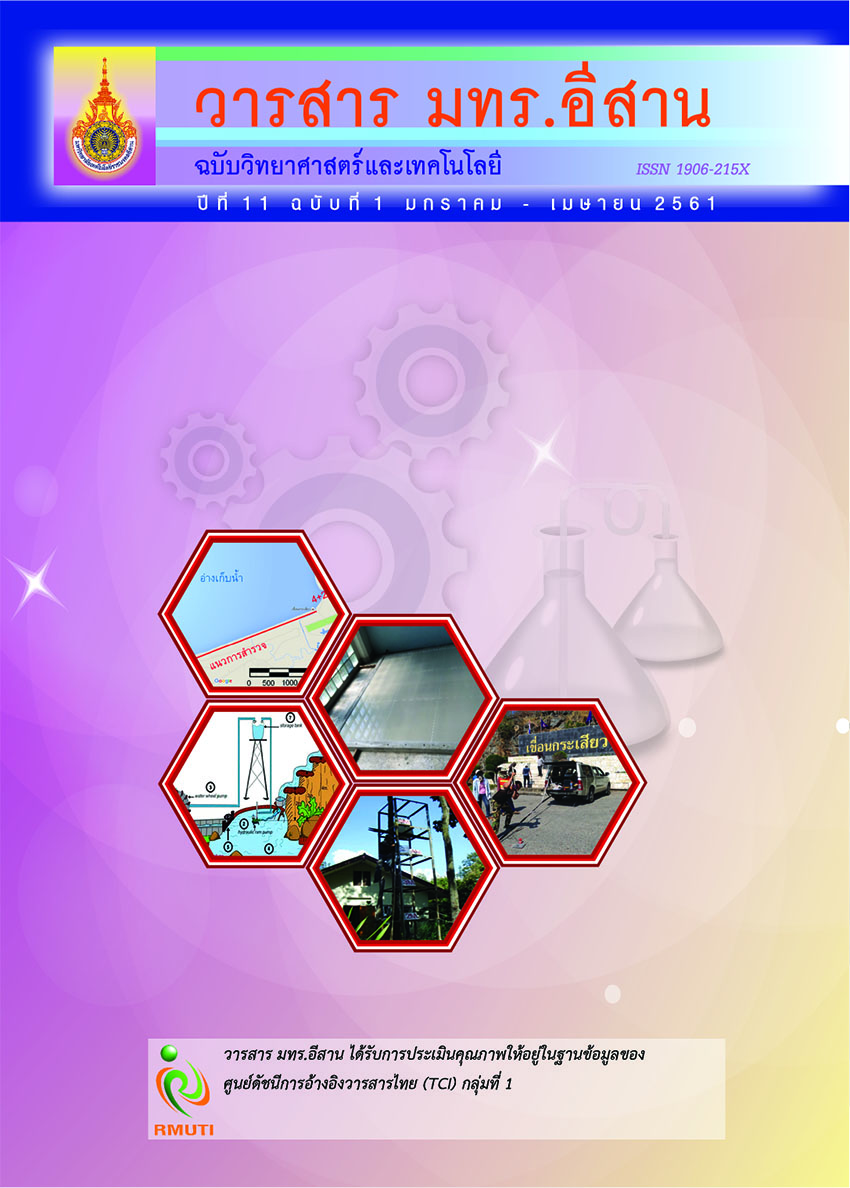A Study of the Potential of Planting, Yield and Utilization of Napier Pakchong 1 Grass as Feedstock for Renewable Energy in Lam Chiang Krai Watershed, Nakhon Ratchasima Province
Main Article Content
Abstract
This research aims to evaluate land, determine suitable areas for the Napier Pakchong 1
grass, using the principles of the Food and Agriculture Organization of the United Nations,
and study the potential of planting, yield and utilization as feedstock for renewable energy
in Lam Chiang Krai watershed, Nakhon Ratchasima province. An experimental design of
2 x 5 factorial in RCBD, with 4 replication was created including the diff erent electrical
conductivity of the two experimental plots (6.58, 7.80 dS/m) and the fi ve periods of plant
age (30, 45, 60, 75, 90 days). The results revealed that the majority of watershed’s area was
moderately suitable area (84.78 %), with EC 4 - 8 dS/m, and Low nutrient availability index,
therefore, fertilizing before planting was necessary for good results. It was found that the
experimental plot at EC 6.58 dS/m was higher than that of the experimental plot at the EC
7.80 dS/m in all ages, signifi cantly (P < 0.01), except for the number of shoots per clump;
NDF fi ber and ADF fi ber, had no statistical signifi cant diff erences (P > 0.01). Overview,
the quantity and quality of grass on the experiment at 90 days revealed that the highest
yields, harvesting 4 times per year. The Utilization showed that the potential areas yielding
fresh grass for the power generation of the suitability areas including highly, moderate and
marginal areas were 0.47, 84.78 and 6.13 % of the watershed, respectively. Thus, overview
of the watershed area had an average of fresh grass yield at 61.11 tons per rai per year
with the spatial yield of 60 %. The potential of the fresh grass yield for power generation
mean was at 37.45 milliontons per year, power generation at 1,044.99 megawatts.
The moderate suitable area had the highest fresh grass yield potential for maximum power
generation.
Article Details
References
Thailand Energy. Energy Knowledge Management. Access (9 September 2016). Available
(https://energy.go.th/km-energy/wp-content/uploads/2016/ 08/AEC5.pdf)
[2] Bandit Uea-aphon. (2012). The Energy Crisis with the Direction of the AEC Linkages,
and Exit of Thailand 1/4. Access (9 December 2013). Available (https://www.siamintelligence.
com/energy-crisis-linkages-aec-and-thai-1-4/)
[3] Noinumsai, N. and Foypikul, W. (2012). Saline Soil Distribution Potential Assessment and
Ecological Environmental Technology Development for Rehabilitate Lam Chiang Kai
Basin Ecosystem in Non Thai District, Nakhon Ratchasima Province. Research report.
Nakhon Ratchasima Rajabhat University (in Thai)
[4] Buranasing, N. (2015). Energy Crop : Napier Grass. Access (13 February 2016). Available
(https://www.parliament.go.th/ewtadmin/ewt/parliament_parcy/ewt_dl_link.php?nid=30598)
[5] Kiyothong, K. (2011). Napier Pakchong 1 Grass Manual. Nakhon Ratchasima : Mittraphap
Karnpim (in Thai)
[6] Chongjian Ma., Ravi Naidu., Faguang Liu., Changhua Lin., and Hui Ming. (2012). Infl uence
of Hybrid Giant Napier Grass on Salt and Nutrient Distributions with Depth in a Saline Soil.
Biodegradation. Vol. 23, No. 6, pp. 907-916. DOI: 10.1007/s10532-012-9583-4
[7] Food and Agriculture Organization of the United Nations. (1983). Guideline : Land
Evaluation for Rainfed Agriculture. FAO soils bulletin no:52 0253-2050. Bibliography.
pp.233-237
[8] Charuppat, T. (2002). Landuse Change Detection, Land Evaluation and Landuse Planning
in Lam Phra Phloeng Watershed. Doctor of Science Thesis in Soil Science, Graduate School,
Khon Kaen University (in Thai)
[9] Sys, C., Van Ranst, E., and Debaveye, j. (1991). Land Evaluation-Part I : Principles in Land
Evaluation and Crop Production Calculation. Agricultural Publication-Number 7. General
Administration for Development Cooperation. Place du Champ de Mars 5 bte 5-1050 Brussels,
Belgium
[10] Tansiri, B. (1999). A Guide to Evaluation Land for Crops. Bangkok : Offi ce of Soil Resources
Survey and Research, Land Development Department
[11] Land Development Department. (2004). Management of Soil Salinity. Bangkok : Ministry of
Agriculture and Cooperatives
[12] Ayers, R. S. and Westcot, D. W. (1994). Water Quality for Agriculture. FAO Corporate
Document Repository. Handbook. Access (25 December 2013). Available : (https://www.fao.
org/docrep/003/T0234E/T0234E00.html)
[13] Goering, H. K. and Van Soest, P. J. (1970). Forage Fiber Analysis (apparatus, reagents,
procedures and some applications). USDA Agricultural. Handbook, No. 379. Access (25 May
2015). Available (https://naldc.nal.usda.gov/download/CAT87209099/PDF)
[14] Jeenanurugk, D. (2014). The Feasibility Study of Investment on Biomass Power Plant
from Napier Pakchong 1 Grass Amphoe Muak Lek Changwat Saraburi. Master of Economics,
Business Economics, Faculty of Economics at Sriracha (in Thai)
[15] Encyclopædia Thai. (n.d). Some Important Properties of Soil Associated with Cultivation.
The Encyclopedia Project for Thai youth. Vol. 18, Title 8. Soil and Fertilizer. Access (30 April
2015). Available (https://kanchanapisek.or.th/kp6/sub/book/book.php?book=18&chap=8&page=
t18-8-infodetail04.html)
[16] Kareerat, N., Siriwi, S., and Reungsang, P. (2015). Spatial Identifi cation of Suitable Area for
Napier Grass Energy Crop Planting in Northeast of Thailand. Access (23 October 2016).
Available (https://www.arts.chula.ac.th/~geography/TSG2015/docs/FullPaper/FullPaper/1.8%20
Napier%20Grass.pdf)
[17] Wijitphan, S. (2011). Eff ects of Cutting Interval on Yields and Nutritive Values of King Napier
Grass (Pennisetumpurpureumcv. King grass) under Irrigation Supply. KKU Research Journal.
Vol. 6, No. 3, pp. 215-224 (in Thai)
[18] Hoshino, M. (1975). Studies on the Tropical Forage Crop in Thailand. TARC. Ministry of
Agriculture and Forestry. Japan
[19] Satchapong, R., Maneerat, W., and Putsakum, M. (2007). Eff ect of Napier Pak Chong 1 Grass
on Productive Performance in Thai Lavo Chicken. In the 5th STOU Graduate Research
Conference. November 27, 2015. Sukhothai Thammathirat Open University. P-ST 026. (in Thai)
[20] Kulasuwan, P., Thobunluepop, P., Tonmukayakyl, N., Mani-in, P., Pongtip, A., Muangpan, J.,
Vinijchevit, N., and Changkaewmanee, J. (2014). Eff ect of Seassonal and Cutting Interval of
Napier Pak Chong 1 on Growth Biomass and Biogas Productivity. Agricultural Science
Journal. Vol. 45, No. 2, pp. 721-724 (in Thai)


